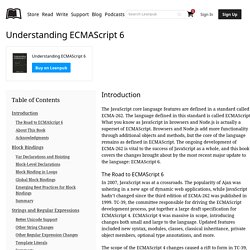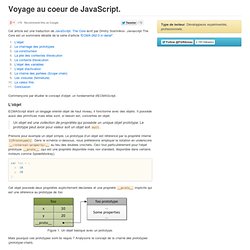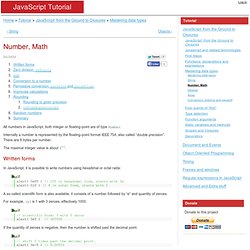

AlexNogard : Tutos IT Linux : Supervision : Centreon, Nagios, Owncloud; Windows Server 2012 : Hyper-V 3. Read Understanding ECMAScript 6. Introduction The JavaScript core language features are defined in a standard called ECMA-262.

The language defined in this standard is called ECMAScript. What you know as JavaScript in browsers and Node.js is actually a superset of ECMAScript. Browsers and Node.js add more functionality through additional objects and methods, but the core of the language remains as defined in ECMAScript. The ongoing development of ECMA-262 is vital to the success of JavaScript as a whole, and this book covers the changes brought about by the most recent major update to the language: ECMAScript 6.
The Road to ECMAScript 6 In 2007, JavaScript was at a crossroads. The scope of the ECMAScript 4 changes caused a rift to form in TC-39, with some members feeling that the fourth edition was trying to accomplish too much. ECMAScript 3.1 introduced very few syntax changes, instead focusing on property attributes, native JSON support, and adding methods to already-existing objects. About This Book Overview Summary. AngularJS. Javascript quiz. I was recently reminded about Dmitry Baranovsky's Javascript test, when N.

Zakas answered and explained it in a blog post. First time I saw those questions explained was by Richard Cornford in comp.lang.javascript, although not as thoroughly as by Nicholas. I decided to come up with my own little quiz. I wanted to keep question not very obscure, practical, yet challenging. They would also cover wider range of topics. Host objects Contrary to Dmitry's test, quiz does not involve host objects (e.g. window), as their behavior is unspecified and can vary sporadically across implementations. So what are we testing? Rivets.js — Lightweight and powerful data binding + templating solution for building modern web applications. Shaping up with Angular.js. Voyage au coeur de JavaScript (ECMAScript 3) Cet article est une traduction de JavaScript.

The Core écrit par Dmitry Soshnikov. Javascript The Core est un sommaire détaillé de la série d’article “ECMA-262-3 in detail”. Commençons par étudier le concept d'objet, un fondamental d'ECMAScript. L'objet ECMAScript étant un langage orienté objet de haut niveau, il fonctionne avec des objets. Un objet est une collection de propriétés qui possède un unique objet prototype. Prenons pour exemple un objet simple. Cet objet possède deux propriétés explicitement déclarées et une propriété __proto__ implicite qui est une référence au prototype de foo: Mais pourquoi ces prototypes sont-ils requis ? Le chaînage des prototypes Les prototypes sont des objets comme les autres et peuvent posséder leurs propres prototypes. Une chaîne de prototype est une chaîne finie d'objet utilisé pour implémenter l'héritage et le partage de propriétés. Examinons le cas où nous avons deux objets qui diffèrent sensiblement.
Scotch ♥ Developers bringing fire to the people. Read JavaScript Allongé. A Pull of the Lever: Prefaces “Café Allongé, also called Espresso Lungo, is a drink midway between an Espresso and Americano in strength.

There are two different ways to make it. The first, and the one I prefer, is to add a small amount of hot water to a double or quadruple Espresso Ristretto. Like adding a splash of water to whiskey, the small dilution releases more of the complex flavours in the mouth. “The second way is to pull an extra long double shot of Espresso. Foreword by Michael Fogus As a life-long bibliophile and long-time follower of Reg’s online work, I was excited when he started writing books.
The act of writing is an iterative process with (very often) tight revision loops. In the case of JavaScript Allongé, you’ll find the Leanpub model a shining example of effectiveness. As a staunch advocate of functional programming, much of what Reg has written rings true to me. You Might Not Need jQuery.
JavaScript Tutorial. All numbers in JavaScript, both integer or floating-point are of type Number.

Internally a number is represented by the floating-point format IEEE 754, also called “double precision”. There are 8 bytes per number. The maximal integer value is about 253. Written forms In JavaScript, it is possible to write numbers using hexadimal or octal radix: A so-called scientific form is also available, it consists of a number followed by “e” and quantity of zeroes. For example, 1e3 is 1 with 3 zeroes, effectively 1000. If the quantity of zeroes is negative, then the number is shifted past the decimal point. Zero division, Infinity Imagine, you are to create a new language. What should happen if someone divides by zero? Usually the answer is “Zero Division Error”. JavaScript. A Fullstack Javascript Framework. Grow your expert full-stack JavaScript skills with tagtree screencasts.
Tutoriels ExtJ4. Javascript. Atinux - Vous allez aimer le JavaScript. JQUERY.